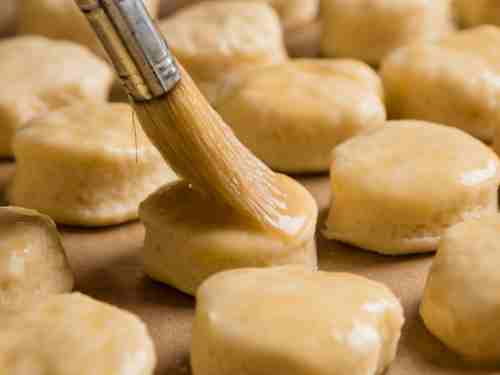It’s often used to make bread, pie, or rolls. If you’ve ever wondered about how to make an egg wash and which recipe is the best, you should go through this article.
We’re testing all the various combinations of milk, egg, and water to find the most effective method to create egg wash to make pie!
What is Egg Wash?
Egg wash is essentially the result of beating eggs together with milk (or cream). If it is added to doughnuts, pastry shells, bread made with yeast as well as other baked items before baking, the egg wash gives a golden-brown sheen, which makes these sweets look delicious.
What is Eggwashing?
There are a variety of variations for egg wash. You are free to play around to discover the mix which best fits your baked products. In general, ensure a ratio of 3:1 of liquid to egg. The crust will get shinier and darker when you reduce the amount of liquid.
To get a darker brown sheen with a crisper crust, you can use water.
For a light and slightly shinier sheen with a soft crust, you can use dairy or thick cream.
To get a thicker, more pliable crust that has a little sparkle, use only the egg white as well as water.
To achieve a deeper, darker shade, you should use just the yolk of an egg.
The Science of EGG WASH

The impact of egg wash on the baked goods you bake will depend on the type of wash you pick. This is due to the protein and fat in eggs can produce various outcomes. For instance, the protein present in egg white can cause an appearance of gloss, while the fat found in the yolk causes golden brown coloring.
The egg white can create an attractive baked pie, but without yolks, there is lesser browning. If you’re looking for an appearance that is shiny and golden brown, make sure you employ egg wash, which is made up of egg yolks and white.
The same idea about protein applies to the liquid you decide to thin the egg. Since milk is rich in protein and contains more sugar, mixing egg wash using milk will give your egg a greater shine. However, cream, due to its fat content, similar to the yolk, can enhance the effect of browning.
Types of Egg Washes to make
Okay, let’s look at the various kinds of egg wash that you can create, including some of which don’t even contain eggs! I’ll also give you the go-to egg wash I use for almost every task.
Only Egg
A light brushing of an egg can result in an even darker caramelized baked product with a moderate amount of shine.
Only Egg Yolk
The simple act of brushing the whisked egg yolk can result in a rich golden brown baked good with a nice shine.
Only Egg White
The application of egg whites will result in a more pale baked product with an excellent shine. An egg white-only wash can be used to brush onto the surface of blind-baked pie crusts to form an airtight seal between the pie filling as well as the crust. Also, it can be used to assist in making the sugar stick to the pastry.
Egg and water
Brushing eggs with water can result in baked goods that are golden brown with a decent level of sparkle. I think of this as an eggwash that can be used for any purpose and is the one that I often turn to.
Egg, Milk, or Cream
The brushing of eggs whisked in cream, or milk can produce light and golden baked goods with plenty of sparkles.
Only cream or milk
It is typically applied to the biscuits’ tops or pastries. The baked pastry is left with an appearance that is somewhat shiny, without any browning.
Tips to Make Use of Egg Wash
- Just prior to putting your pie in the oven, paint the top of your pie with an egg wash to ensure they cook golden brown and shiny. Make sure to take your pie crusts made of lattice up a level with eggs and a wash. Do you have a Puff pastry that has been frozen? Maximize the use of the pre-packaged pastry by slapping it using egg wash. Of course, I believe that everyone will be of one mind that homemade or store-bought dinner rolls are more appealing by that shiny golden hue.
- Although I strongly advocate making use of an egg wash as often as feasible, I’d be remiss, not to mention the possible safety concerns in handling eggs that are raw. Make sure you clean your pastry brush promptly after using it. After that, wash it in cold water to avoid the egg from getting coagulated. After rinsing it in cold water, wash the brush using soap, and then wash it with hot water. This will clean it. As previously mentioned, the silicone brush will provide the easiest cleaning (plus it doesn’t absorb unpleasant smells).
- To prevent cross-contamination that could result in Salmonella, Handwash your hands after handling eggs that are raw. It is also important to clean the dishes and utensils you use to cook eggs. Afterward, ensure you wash all surfaces where eggs could have come into contact.
HOW to store
If you don’t want to use all of the egg wash you used for baking, it can be stored inside an airtight container and keep it in the fridge for up to 3 days. I usually just mix it into scrambled eggs on the next day. However, if you are baking it again in a couple of days, you’ll be prepared!